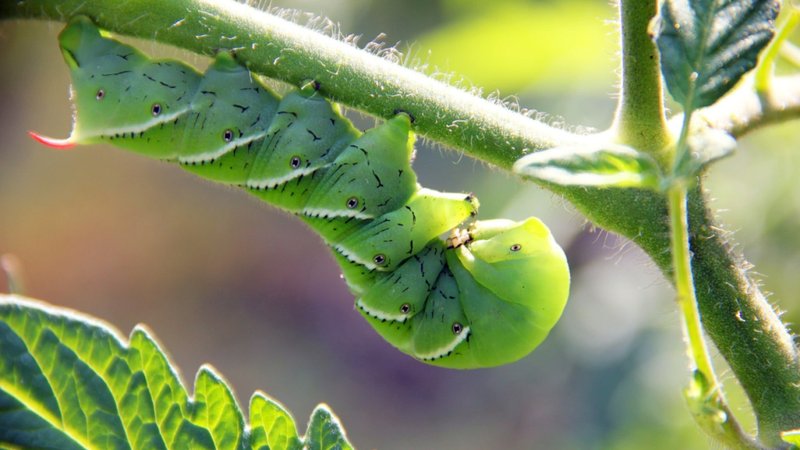
Think of hornworms like uninvited houseguests. They show up without warning, make a big mess, and leave you scrambling to fix things. And while they might look harmless, they can be downright devastating to your crops. So, how can you guard your garden against these little gremlins? Let me explain some practical prevention tips that will help keep your raised beds safe from hornworms and their destructive ways.
What Are Hornworms and Why Do They Matter?
Hornworms are the larval stage of hawk moths, and they can grow quite large—up to 4 inches long! These caterpillars are typically green with a horn-like structure on their back, making them easy to spot if you’re looking closely. Despite their cute name, hornworms are notorious for their insatiable appetite, especially for tomatoes, peppers, and eggplants.
Why should you care? A single hornworm can devour a tomato plant in just a few days, leaving behind nothing but bare stems. If you’re investing time and effort into your garden, you want to protect it from these little marauders. Understanding hornworms and their life cycle is the first step in preventing them from wreaking havoc in your raised beds.
Identifying Hornworm Damage
The first line of defense is knowing what hornworm damage looks like. Typically, you’ll notice large, irregular holes in the leaves of your plants. If you spot frass—tiny, dark pellets—on or around your plants, that’s a sure sign you have hornworms munching away.
Honestly, they can be pretty well camouflaged, blending perfectly with the green leaves. So, when checking for them, look under the leaves as well. If you catch them early enough, you can simply pick them off by hand and dispose of them. **Here’s the thing**: the sooner you act, the less damage they’ll cause.
Creating an Uninviting Environment
Preventing hornworms starts in the planning stages of your garden. One effective method is to create an environment that’s less welcoming to them. Here are a few strategies you can implement:
- Plant Diversity: Instead of growing large patches of the same crop, mix up your planting. This confuses pests and makes it harder for them to find their preferred food.
- Companion Planting: Some plants repel hornworms. For example, marigolds can help deter these pests. Consider adding them around your raised beds.
- Crop Rotation: Changing the placement of your crops each season disrupts the hornworm’s life cycle. They won’t find the same food source year after year.
Making your garden less appealing to hornworms not only protects your plants but also promotes overall garden health.
Natural Predators and Beneficial Insects
Another great way to keep hornworms at bay is to attract their natural predators. Birds, wasps, and other insects play a vital role in controlling hornworm populations. You can make your garden a friendly spot for these helpful creatures by planting flowers and herbs that attract them.
For instance, flowers like **nectar-rich cosmos** or **zinnias** can draw in beneficial insects like ladybugs and lacewings, which feed on caterpillars. Here’s an idea: you might even consider hanging bird feeders or birdhouses in your yard. More birds mean more natural pest control, and who doesn’t love the sight of birds flitting around?
Using Physical Barriers
Sometimes, the simplest solutions can be the most effective. Physical barriers, like row covers or garden netting, can keep hornworms from reaching your plants. These barriers are especially helpful in the early stages of a plant’s life when they’re most vulnerable.
Make sure to use lightweight fabric that allows sunlight and rain to reach your plants. You’ll be pleasantly surprised at how well this can work! Just remember to keep the edges secured to prevent any sneaky pests from slipping underneath.
Organic Pesticides: A Last Resort
If you find yourself facing a serious hornworm infestation that’s beyond handpicking, you may consider using organic pesticides. Products containing **Bacillus thuringiensis (Bt)** are specifically designed to target caterpillars while being safe for beneficial insects.
It’s important to follow the directions on the label closely. Here’s the thing: while these pesticides can help manage hornworm populations, it’s always best to explore preventative measures first. Using chemicals should be a last resort, as we want to keep our gardens as healthy and organic as possible.
Monitoring and Regular Checks
Regularly checking on your plants is essential to keeping hornworms at bay. Set aside a few minutes each week to inspect your raised beds. Look for any signs of damage or droppings. Getting into this habit can save you a lot of trouble down the line.
Also, don’t forget to involve your family in this process! Gardening is a great way to spend time together, and teaching children to spot pests can be a fun and educational activity. Besides, who doesn’t want a gardening buddy?
Final Thoughts
Hornworms might seem like a small problem, but they can cause significant damage if left unchecked. By adopting some preventive measures, such as creating an unfriendly environment, supporting natural predators, and staying vigilant, you can enjoy a healthy, productive garden. Remember, healthy plants are your best defense against pests.
So, the next time you stroll through your raised beds, keep an eye out for those sneaky caterpillars. With a little dedication and the right strategies, you can keep your garden thriving—hornworm-free! Happy gardening!

